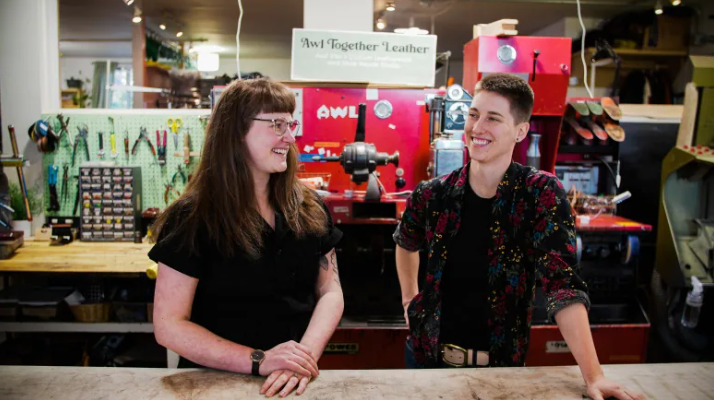These Metro Vancouver businesses want to make it easier for you to hold onto your clothes longer Social Sharing

If a material cannot be recycled, the best thing to do is to make it last longer, says one entrepreneur
A whirring sound fills the room as Tess Gobeil switches on a red machine, and a wheel begins to spin.
She holds up a sandal and runs its soles against the wheel’s surface, smoothing its edges.
The sanding belt is one of several wheels on the large piece of equipment used to restore shoes, including the one in Gobeil’s hand — one of many in the queue for repairs at Awl Together Leather.
Since opening in 2021, the East Vancouver shop has repaired everything from knitted cardigans and denim jeans to leather boots. This year, they’ve served more than 7,500 customers.
Amid mounting concerns over textile waste, repairs offer one last resort for damaged clothes before they end up in a landfill.

“You can buy new shoes every six months to a year, but when you choose to repair it, you’re making a choice that these are my boots, and I want to keep wearing them,” said Gobeil, who co-founded the studio.
“It’s just a commitment to deciding that’s what you’re going to do and taking it seriously and personally.”
Textiles are one of the world’s fastest-growing sources of waste. According to the UN, the clothing and textile industry contributes up to eight per cent of the world’s greenhouse gas emissions.
- Textile waste is a growing problem — and Canada still isn’t doing enough to solve it, experts say
- In Metro Vancouver, 20,000 tonnes of clothes get thrown out each year
In Metro Vancouver, residents throw out about eight kilograms of clothes — the weight of around 44 T-shirts — per person annually. The closure of Return-It textile recycling bins earlier this year has also meant fewer ways to deal with old or damaged clothes.
All this is why young businesses like Awl Together say they want to make repairs easier and more accessible.
‘A memory piece’
About a 15-minute drive south, a Richmond studio is taking on another type of clothing: outdoor gear, including down jackets, waterproof pants and ski attire.
“I want to use my … knowledge in technical apparel to repair as much as possible,” said Vincent Guo, who founded Renewt Technical Apparel in 2020.

The manufacturing engineer, who has worked for brands like Arc’teryx, says waste management teams used to tell him how some waterproof materials, including those made of plastic, would be incinerated because they couldn’t be recycled.
“If this material cannot be fully recycled,” he said, “the best way is to make the use-life longer.”
- Campaign to curb clothing waste reaches Metro Vancouver residents, review shows, but recycling will get harder
- Closure of Return-It textile recycling program could add to landfills, advocates say
Costs range from $15 for simple fixes — small rips that need to be stitched, for example — to about $200 for more complex repairs requiring specialized techniques.
But Guo says some customers are willing to spend more if an item means something to them.
“Like my mother bought it for me, or I’ve been wearing it for 10 years,” he said. “It’s a memory piece.”
Making repairs more accessible
According to one Vancouver-based consultant, the demand for clothing repairs is growing among shoppers.
More than half of consumers, for example, say brands need to play a greater role in reducing fashion’s environmental impact, online consignment store ThredUp notes.
“There’s … this bubbling up of awareness, but we still have an utter lack of accessibility or understanding about how to actually take the tangible steps to access these [repairs] services,” said Devon de Balasi Brown.
While seamstresses and cobblers have always been around — Metro Vancouver has more than a dozen alteration and shoe repair shops — some say they want these services to be easier to access.

“The whole repair economy is the next thing … in the circular economy,” said Jiaying Zhao, an associate professor in psychology, referencing the framework wherein items are reused, refurbished, repurposed, repaired or recycled, so nothing goes to waste.
“I just think that the services, repairs are not prevalent.”
Zhao, who researches behavioural changes toward sustainability at the University of British Columbia, says people would be likelier to repair their clothes if services were more widely available and accessible.
-
MARKETPLACE
What really happens to old clothes dropped in those in-store recycling bins
-
IN DEPTH
B.C. is a recycling leader, but experts say it’s time to turn to waste reduction
It’s a problem de Balasi Brown says he wants to solve — by teaming up directly with retailers.
This month, he founded Spruce Circularity, a subscription program for brands that offer clothing repairs and refurbishment, offloading the need for them to build and operate those services in-house.

“It all comes down to making it convenient,” he said.
“There’s just no way we can keep going the way we are in terms of the amount of waste that we’re creating as a society.”
Repairs as a hobby
Even as they help others, the founders of Awl Together say it’s just as important to learn to repair our own clothes.

“It’s something that you can do yourself if you’re looking for a new career or even just a fun new hobby at home,” said co-founder Ariss Grutter.
“People who repair at home, their own garments, who darn their own socks … that’s important too. That’s a part of the repair economy that keeps stuff out of the landfill.”
Related News
Canadians required to register with U.S. government if in country at least 30 days
Many Canadians travelling to the United States will now have to newly register with theRead more
Duty-free shops struggle to make ends meet as Canadians steer clear of U.S.
If business doesn’t pick up soon at his duty-shop, Éric Lapointe says he’s going toRead more
